Unless you have a dog that smashes his toys in a matter of minutes, there’s a good chance his favorite toy could have hidden infectious material.
In this article, we’ll go over when and how often you should be cleaning different types of dog toys. We’ll also provide tips on the best cleaning methods for plush, rope, rubber, and puzzle toys.
Let’s dive in.
Contents
Why You should Clean Dog Toys
It’s no secret that dogs absolutely love their toys, but let’s face it – all that enthusiastic chewing and slobbering can make those toys a haven for bacteria and germs. Think about it: every time they play, they’re basically giving their toys a good coat of saliva, which is a perfect breeding ground for some not-so-friendly bugs like Salmonella, E. coli, and Staph. And let’s not forget all the mud, dirt, and who-knows-what-else they’re dragging in from their outdoor adventures.
That’s exactly why giving those toys a good scrubbing and disinfecting isn’t just a good idea – it’s essential. It’s not just about getting rid of the mud stains or making the toys look clean. It’s about zapping those invisible germs that could be hanging out on their favorite squeaky ball or chew rope.
Regularly cleaning their toys means keeping your furry best friend healthy, and, bonus, it could save you a trip (and a bill) from the vet for something that’s totally preventable.
How often You should Clean Your Dog’s Toys
The frequency of washing your dog’s toys depends on several important factors:
Consider Toy Material
Soft, porous materials like plush fabric and rope are more prone to holding onto dirt, germs, and moisture. These toys need frequent cleaning to prevent mildew, bacteria growth, and bad odors. Aim to wash plush or stuffed toys at least weekly.
In contrast, hard, non-porous materials like rubber, nylon, and plastic do not absorb moisture or germs into their surfaces. These toys only need occasional cleaning, such as monthly or when visibly dirty.
Consider Play Style
Does your pup love to aggressively chomp, chew, and wrestle with their toys? Intense chewers and rough players will get their toys much dirtier much faster. All that excessive slobbering, biting, tossing, and tugging leads to a rapid buildup of dirt, drool, and debris on the toy’s surface.
For dogs that really get their toys grungy through intense play or chewing, plan to wash their active toys more frequently than toys used for gentle mouthing or casual fetching.
Outdoor Toys need more Care
Toys that join your dog on walks visit dog parks or daycare facilities and require more frequent cleaning. These community areas harbor significantly more germs and parasites than home environments. Outdoor toys also collect dirt, mud, feces, and other contaminants, demanding thorough washings. Stick to toys designated for outside use only to keep home toys cleaner between washings.
Consider Health Issues
Dogs with compromised immune systems, chronic illnesses, or infections need extra care taken with their toys. More frequent and thorough washing and disinfecting of their toys removes germs that could re-infect your pup and cause their condition to worsen. This level of toy hygiene helps prevent complications from diseases.
Consider Food Diets
Dogs fed raw food diets naturally shed higher amounts of dangerous bacteria like Salmonella and Listeria through their saliva and feces. Their toys become contaminated with these germs through playing and chewing after meals—Disinfect toys after each use to protect human family members from potential transmission.
General Toy Washing Guidelines
Given all these factors, follow these general guidelines for routine toy washing:
- Plush Toys: Wash weekly
- Rubber/Nylon/Plastic Toys: Wash monthly
- Ball/Frisbees: Wash weekly if used outdoors, monthly if only used indoors
- Rope Toys: Wash weekly
- Squeaky Toys: Wash weekly
- Teething Toys: Wash daily
Signs Toys need Cleaning
Aside from following a washing schedule, look for visual and odor cues that toys need freshening up:
- Strong odors
- Visible stains
- Dirt, slobber, or debris buildup
- Slimy or greasy feel
- Discoloration
Frequent toy washing keeps your pup safe and happy while extending the usable life of beloved toys!
How do You Wash Dog Toys?
Most dog toys come with care and cleaning instructions, typically printed on the toy or attached tag. It’s best to stick to these manufacturer-provided guidelines for cleaning and sanitizing your dog’s toys. In cases where such instructions are missing, rely on your own judgment, complemented by the general tips we’ve outlined.
How to Clean Dog Rope Toys
Dog rope toys easily trap dirt, slobber, and debris within their fibers, so a weekly cleaning routine is ideal for sanitization and preventing unpleasant smells.
If the rope toy is particularly dirty, start by soaking it in a large bowl of warm water mixed with some detergent. Let it sit for a few hours; this will help loosen and remove much of the grime before the actual washing.
Machine washing is the simplest way to clean rope toys. Simply put the toy in a garment bag and select a gentle wash cycle with cold water. It’s best to use a mild dog shampoo or detergent made for sensitive skin, and it’s recommended to avoid using fabric softener.
For those who prefer handwashing, immerse the rope toy in warm, sudsy water, then rinse it thoroughly. Allow it to air dry, but keep it away from direct sunlight to prevent damage.
After washing, you can disinfect the rope toys. A bleach solution works well for this purpose. Mix 1 tablespoon of bleach with 1 gallon of water and soak the toys for 5 to 10 minutes. Ensure you rinse them thoroughly afterward.
Alternatively, vinegar serves as an excellent natural disinfectant. Create a mixture of 1 part vinegar to 10 parts water, and soak the toys for about 15 minutes following their wash. This method is effective and safe for keeping your dog’s rope toys clean and hygienic.
How to Clean Bamboo Dog Puzzle Toys.
Bamboo, a natural material, can be sensitive to harsh cleaning methods. The best way to clean these toys is handwashing. Use warm water, mild soap, and a soft brush to gently scrub away any slobber and dirt that may have settled into the grooves and crevices of the puzzle. This method ensures that you’re thorough without being too abrasive.
Once you’ve cleaned the toy, it’s important to rinse it thoroughly. However, be cautious not to leave the bamboo submerged in water for too long, as this can result in cracks and warping, reducing the toy’s lifespan.
For an additional step, you can disinfect bamboo puzzle toys using a dilute vinegar solution. A mixture of 1 tablespoon of vinegar per quart of water is effective for this purpose. This natural disinfectant will help keep the toy hygienic without damaging the bamboo. After applying the solution, make sure to rinse the toy thoroughly.
Always allow the bamboo toy to air dry fully before giving it back to your pup. This step is crucial to ensure that the toy is completely clean and safe for play.
You asked for it, so here’s a roundup of some of my favorite bamboo dog toys that have a pleasing aesthetic. They are ideal for playtime at home without adding too much color to your neutral space, you know?
1
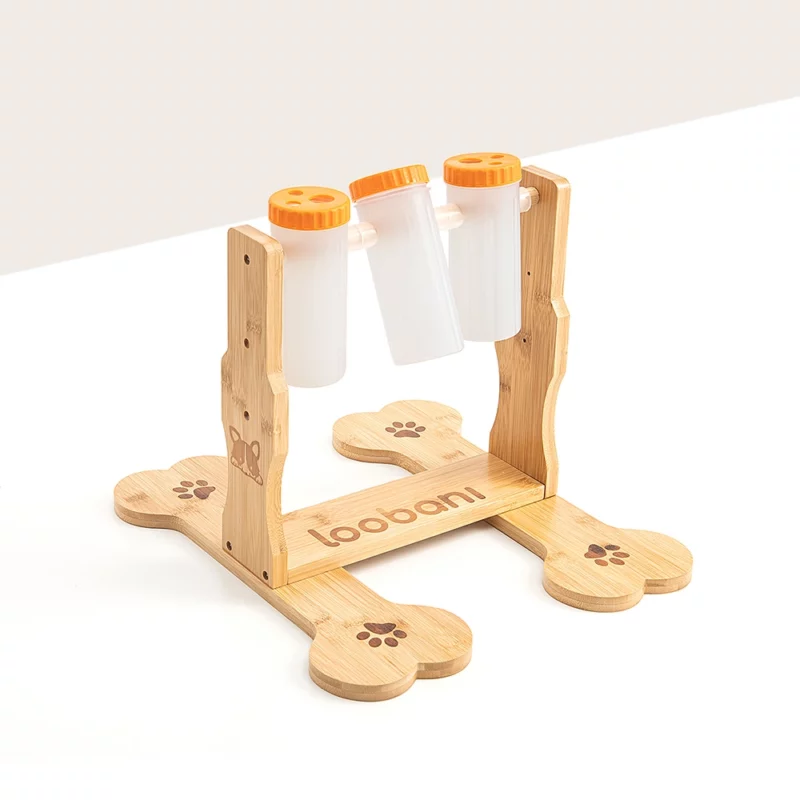
BEST FOR ENRICHMENT
Dog “Slot Machine” Toys
2
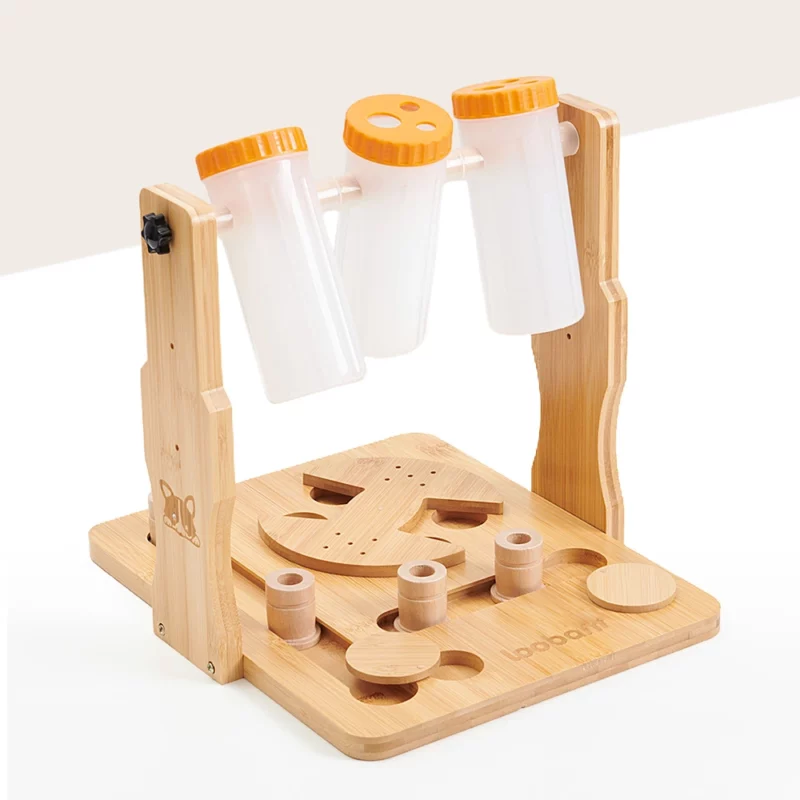
BEST FOR HIGH-ENERGY DOGS
MultiPuzzle Dog Treat Dispensing Toy
3
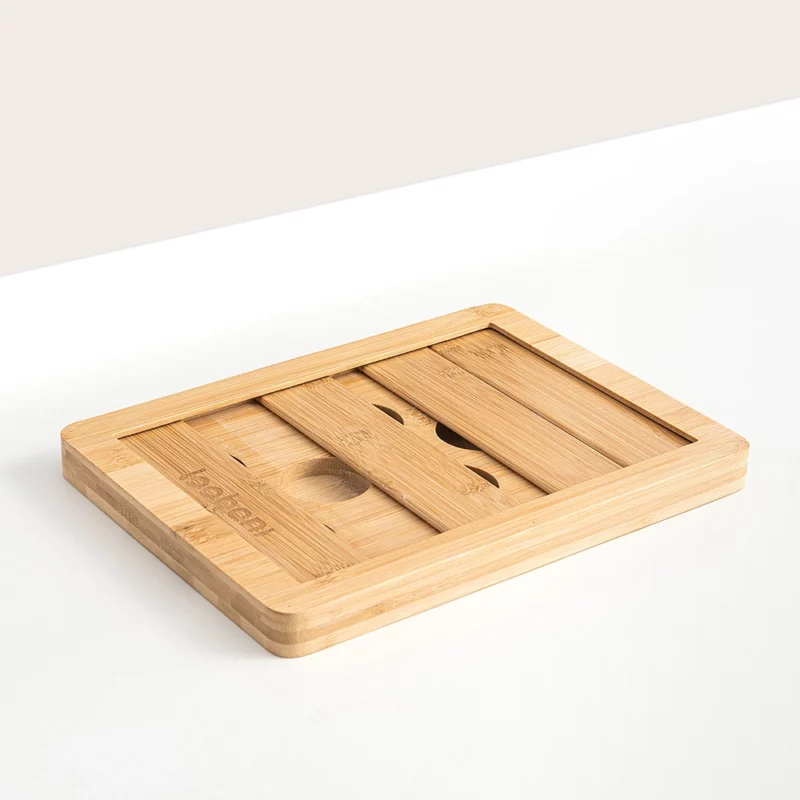
BEST FOR ECO-FRIENDLY PET PARENTS
“Hide-and-Seek” Dog Brick Toy
4
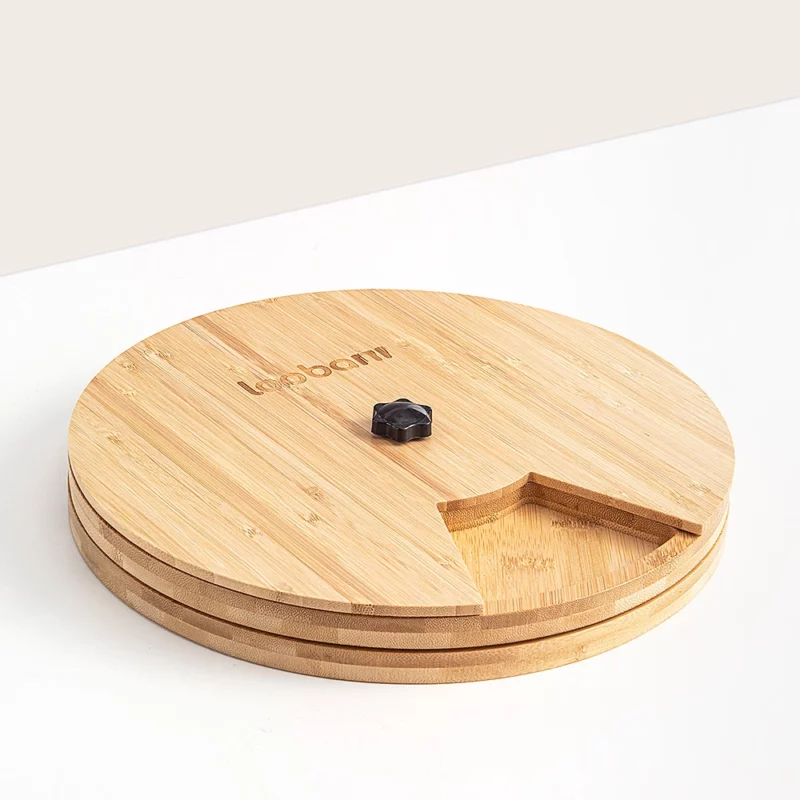
BEST ADVANCED PUZZLE
Double-Layer Dog Activity Board
5
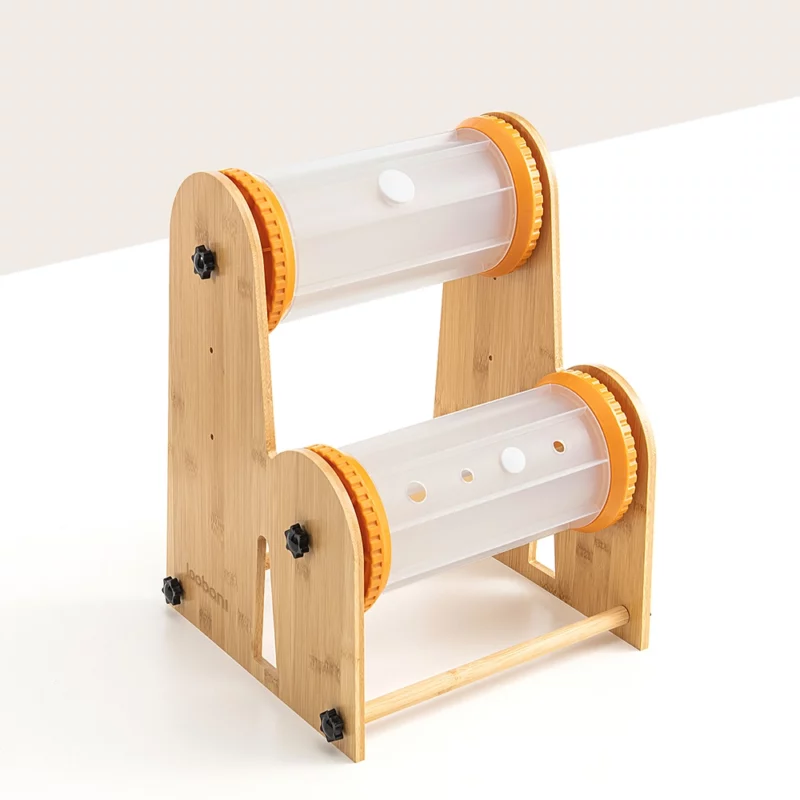
BEST FOR MULTI-PET FAMILY
Multi-Dog Puzzle Playset
How to Clean Rubber, Nylon, and Plastic Dog Toys
Rubber, nylon, and plastic toys— These toys, known for their waterproof and durable nature, can be cleaned effectively in several ways.
One of the easiest methods is using a dishwasher. This is particularly useful for plastic basket-style chew toys. Before using this method, ensure the toys are labeled as “dishwasher safe.” Place them on the top rack of the dishwasher to prevent any heat damage. Opt for a gentle or quick wash cycle, and consider using a pet-safe dish detergent to remove any grime effectively.
If you prefer a more hands-on approach, handwashing is also an effective method. Simply use warm, soapy water along with a scrub brush to carefully clean the surfaces of the toys. It’s important to scrub well to reach all the crevices and spots where dirt and bacteria may build up. After scrubbing, make sure to rinse off all the suds completely.
After washing, whether by hand or dishwasher, using a vinegar solution can be a great natural method to disinfect these hard, non-porous toys. Simply mix vinegar with water in a 1:3 ratio and soak the toys for about 10 to 15 minutes. This step will help ensure that the toys are not only clean but also free from harmful bacteria.
Always allow the toys to air dry completely before returning them to your dog. This final step ensures the toys are safe and ready for your pet to enjoy again.
How to Clean Plush Dog Toys with or without a Squeaker
Caring for your dog’s plush toys, like stuffed animals and squeaky ones, needs a careful approach to keep them in good shape and functioning. For most plush toys, machine washing is fine. Just put them in a garment bag, select a gentle cycle, and use cool water and mild detergent. This helps protect the fabric and the toy’s construction.
Air drying is essential – heat can damage the glue and parts like plastic eyes or squeakers. Give them a fluff to bring back their shape once they’re dry.
If you’ve got delicate plush toys, handwashing is the way to go. A soft sponge, cool water, and mild soap will do the trick, followed by air drying.
For those without squeakers, you can throw them in the washing machine and add tennis balls or socks to keep them from getting banged up.
Spot cleaning works great for small messes and helps keep the toys’ shape. Just use a pet-friendly stain remover and a gentle sponge.
Final Words
I hope you find these methods helpful. Just like brushing their teeth or trimming their nails, washing your dog’s toys is an essential part of routine care. It might require extra effort, but adopting strong hygiene practices is key to preventing harmful germs that could make your furry friend ill.